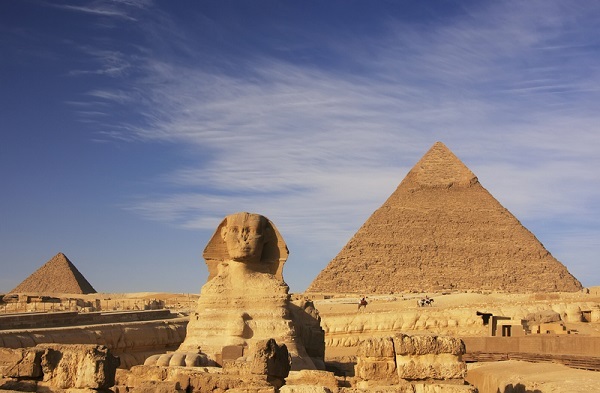

Ancient Egyptian architecture is characterized by the use of massive stone structures, such as pyramids and temples, that were built for religious and funerary purposes. The most famous examples of ancient Egyptian architecture are the pyramids of Giza, which were built during the Fourth Dynasty.
The pyramid's internal structure and layout were also highly symbolic and were designed to protect the pharaoh's body and help his soul ascend to the afterlife. The ancient Egyptians were skilled engineers and used complex techniques to build their monumental structures and transport and place massive stone blocks.

Statue of Pharaoh Khafre
The first pyramids were built during the Third Dynasty of Egypt, around 2600 BCE. These early pyramids were called mastabas and were flat-roofed, rectangular structures built of mud brick.
The most famous pyramids, such as the Great Pyramid of Giza, were built during the Fourth Dynasty. These pyramids were constructed of limestone and granite and had smooth, angled sides, forming a true pyramid shape.
The pyramid shape was thought to symbolize the sun, with the pointed top representing the sun's rays, and the shape of the pyramid itself representing the sun's rays shining down on the earth.
The pyramid was believed to be a place of rebirth for the pharaoh, who would rise from the dead and ascend to the heavens to live among the gods.
The pyramid was also a symbol of the pharaoh's god-like status, and was believed to be a place where the pharaoh would be united with the gods in the afterlife.
Ancient Egyptians developed a writing system known as hieroglyphics, which was used for religious texts and monumental inscriptions.
They also developed a system of mathematics, including the concept of a fraction and the use of a decimal system.
They were skilled engineers and built monumental structures such as the pyramids, using complex techniques to quarry, transport and place massive stone blocks.
They had a complex system of medicine and were able to perform simple surgeries, such as removing tumors and setting broken bones.
They had a complex system of irrigation and used it to cultivate crops in the desert.
They also developed a system of mummification to preserve the bodies of the dead for the afterlife.
They used a sundial to measure time and a water clock to measure the passage of hours.
Ancient Egyptian sculptures were highly stylized and symbolic, often depicting gods and pharaohs in a formal, idealized manner.
They used a technique called frontalism, which emphasized the front of the figure, and profile views were avoided.
They used hieroglyphs in their painting and sculptures.
They used a wide range of materials, including stone, wood, metal, and faience (a type of glazed ceramic).
They often used bright colors in their paintings, such as blue, red, gold, and black.
They often used symbolism in their art, such as the ankh (symbol of life) and the scarab (symbol of regeneration).
They had a deep understanding of balance and proportion and often used it in their sculptures.
The Great Sphinx at Giza: a massive limestone statue of a lion with a human head, thought to represent the pharaoh Khafre.
The statue of Khafre: a granite statue depicting the pharaoh Khafre seated on a throne. This statue is considered one of the most realistic and detailed sculptures from ancient Egypt and it shows the pharaoh in a traditional pose.
The statue of Ramses II: a granite statue depicting the pharaoh Ramses II standing, wearing the double crown of Upper and Lower Egypt.
The statue of Hatshepsut: a granite statue depicting the pharaoh Hatshepsut, the first female pharaoh, standing in a traditional pharaonic pose.
The statue of Akhenaten: a limestone statue depicting the pharaoh Akhenaten, who introduced a new religious doctrine that centered on the worship of the sun god Aten.
The statue of Anubis: a wooden statue depicting the god Anubis, the god of mummification and the afterlife. This statue is considered an important representation of the god Anubis.
The statue of Bastet: a bronze statue depicting the goddess Bastet, the goddess of cats, music, and dance. This statue is considered an important representation of the goddess Bastet.
In conclusion, ancient Egyptian art, architecture, and technology were heavily influenced by their religious beliefs and practices. The art produced during this time period, was highly stylized and symbolic, with a focus on religious and funerary themes. The Egyptian pyramids are one of the most iconic examples of their architectural achievements, serving as both a symbol of the pharaohs' power and prestige and as a place of rebirth for the pharaohs in the afterlife. Their art, architecture, and technology greatly influenced the art and architecture of other cultures and continue to be studied and admired today.
Q1. What was the purpose of hieroglyphics in ancient Egypt?
Ans. Hieroglyphics was the writing system used in ancient Egypt, primarily for religious texts and monumental inscriptions. The system was used to record historical events, religious texts, and to commemorate the pharaohs and their achievements.
Q2. What materials were commonly used in ancient Egyptian sculpture?
Ans. The ancient Egyptians commonly used materials such as stone, wood, metal, and faience (a type of glazed ceramic) in their sculptures. Stone was the most commonly used material for monumental sculptures, while wood, metal, and faience were used for smaller, more portable works.
Q3. How were the ancient Egyptians able to quarry and transport massive stone blocks for the construction of their monumental structures?
Ans. The ancient Egyptians were skilled engineers and used a combination of techniques such as ramps, pulleys, and levers to quarry and transport the massive stone blocks used in their monumental structures. The blocks were transported on barges down the Nile River to the construction site.